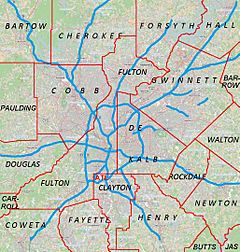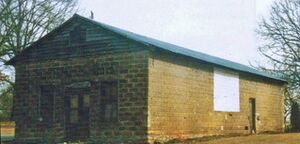Kelleytown, Georgia facts for kids
Quick facts for kids
Kelleytown, Georgia
|
|
|---|---|
| Country | United States |
| State | Georgia |
| County | Henry |
| Time zone | UTC-5 (Eastern (EST)) |
| • Summer (DST) | UTC-4 (EDT) |
Kelleytown is a small, unincorporated community in Henry County, Georgia, United States. Even though it's a separate community, most people in Kelleytown use McDonough as their mailing address. This community is about eight miles (13 km) northeast of downtown McDonough. Many important people from Henry County, like politicians, judges, and business leaders, have come from Kelleytown.
Contents
- Discovering Kelleytown's Past
- Learning at Pleasant Grove School
- Kelley Presbyterian Church: A Community Hub
- Kelley Chapel Baptist Church: A Place of Worship
- The Kelleytown General Store and First Drive-In Theater
- Dr. J.G. Smith and Kelleytown's Power Plant
- Edgar Owen's Waterwheel
- Kelleytown's Location
Discovering Kelleytown's Past
Kelleytown, sometimes called Kelleystown in the early 1900s, has a rich history. Families like the Chafins, Crumbleys, and Kelleys helped build this community. The Kelley family was one of the first families in Henry County. That's why the community and the Kelley Presbyterian Church are named after them.
The Moseley brothers, Silas and Benjamin, were early settlers. Benjamin Moseley's home became the center of Kelleytown. Reuben Kelley, another early settler, married Benjamin's daughter, Mary Moseley. Their old family home and graveyard can still be found off Kelleytown Road.
Kelley Family in the Civil War
Several members of the Kelley family fought in the American Civil War for the Confederate States Army. Thomas Hughey Kelley, son of Reuben and Mary, joined the army in 1862. He was captured during the Battle of Spotsylvania Court House in 1864. Sadly, he died from illness while a prisoner at Fort Delaware in New Jersey.
Captain Henry Holcombe Kelley was another important figure. He lived in Kelleytown with his wife, Alice, and their four children. Henry was a respected leader in Henry County. He commanded a company during the Civil War. In 1900, he hosted a reunion for his old army comrades at his home.
T.C. Kelley: A Community Builder
Thomas Cloud Kelley, known as "T.C.," followed in his father's footsteps. He was a successful businessman in Kelleytown. He owned a large farm, a cotton gin, a sawmill, and a dairy. T.C. Kelley was known for helping Henry County grow. He even served as a commissioner from 1917 to 1920. He was also a member of the Freemasons.
Learning at Pleasant Grove School
The Pleasant Grove School was a private school in Kelleytown. If a family couldn't afford tuition, the community would help pay for their children to attend. The school had two rooms: one for grades 1-3 and another for grades 4-6. Students would go to school here until ninth grade. After that, they would transfer to a school in McDonough. The school closed its doors in 1951.
Kelley Presbyterian Church: A Community Hub
The Kelley Presbyterian Church started from a small Sunday school group in 1896. This group met in the one-room Kelleytown Schoolhouse. In January 1900, the church was officially formed with ten founding members.
Henry Holcombe Kelley donated land for the church building. Two acres next to it were bought for a cemetery. The church was built in 1900 and has been updated over the years. In 1992, an outdoor pavilion was added, which is used for many church gatherings.
In 1997, Kelley Presbyterian was named "Small Church of the Year" for its area. One reason was their "Dogwood Tree Project." Since 1996, they have given over 500 pink dogwood trees to new residents. The church also has a strong tradition of leadership from both men and women.
The church celebrated its 100th anniversary in 2000. It has always been a central part of Kelleytown. Its members are known for their kindness and for helping those in need. In 1950, an article called Kelley Church "one of the landmarks in the state." It was praised for its complete program of community service.
Kelley Chapel Baptist Church: A Place of Worship
The Kelley Chapel Baptist Church began in the late 1800s. It started as a simple outdoor gathering place on Henry Kelley's land. This was a place for the African American community of Kelleytown to worship.
Henry Kelley later donated the land, and the church was officially formed in 1884. The black residents of Kelleytown were respected members of the community. They often worked closely with their white neighbors.
Kelley Chapel Baptist Church and Kelley Presbyterian Church shared a close bond. They would often share books and other materials. In Kelleytown, people shared what they had with others.
The Kelleytown General Store and First Drive-In Theater
The original Kelleytown general store, built in 1908, still stands today. It's at the corner of Airline and Kelleytown Roads. The store was built using blocks made from the red clay dug up for its foundation.
Manse Crumbley, who ran the store, was a very busy man. He also served as the postmaster, doctor, dentist, vet, and accountant for the community. Mail was delivered to the store for residents to pick up. The store stayed open until 1966.
One of the most exciting things about the old store was its "movie screen." A white area was painted on the side of the building. A Kelleytown resident named P.E. Ausband would bring movie reels home. He would project them onto this outdoor screen for everyone to watch for free. People would bring their wagons and wait for the sun to set. This was Henry County's very first drive-in theater!
In the late 1990s, this tradition was brought back for a few weekends. Classic black-and-white movies were shown. More than 350 people came with chairs, blankets, and picnic baskets to enjoy the films.
Dr. J.G. Smith and Kelleytown's Power Plant
In 1918, Dr. J.G. Smith created a plan for a hydroelectric power plant in Kelleytown. This plant used water from Cotton Indian Creek to make electricity. Thanks to Dr. Smith, homes in Kelleytown had electricity even before McDonough did!
Dr. Smith was a very important person in McDonough's history. He started McDonough's first water system. He also owned the first Chevrolet dealership and a local ice company. He even installed a steam engine and electric generator that gave McDonough its first electric street lights.
Today, you can still see parts of the power plant's concrete turbine shafts from the bridge on Airline Road.
Edgar Owen's Waterwheel
In 1916, Edgar Owen built a dam, cotton gin, and gristmill on his property. This project created Kelleytown's most famous landmark: a huge waterwheel. This waterwheel was over 30 feet (9 meters) tall. Many people said it was the largest in the world! The area around the waterwheel was a popular spot for picnics and swimming.
Sadly, Edgar Owen died in an accident involving the waterwheel just one year later. The waterwheel was eventually taken apart in 1966. It was then moved to Stone Mountain Park.
Kelleytown's Location
Kelleytown is located at 33°32′15″N 84°05′20″W / 33.53750°N 84.08889°W.
Main Roads in Kelleytown



